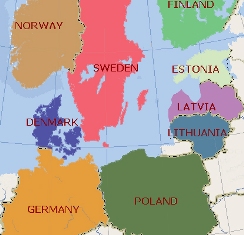 Nordel is the cooperation organisation of the Nordic transmission system operators. Its President, Jukka Ruusunen, said that the huge investment by 2012 would reduce transmission congestion and enable countries connected to the Nordic Grid (Denmark, Finland, Norway and Sweden) to buy their power for a single price more often in the Nordic market that already exists.
Nordel is the cooperation organisation of the Nordic transmission system operators. Its President, Jukka Ruusunen, said that the huge investment by 2012 would reduce transmission congestion and enable countries connected to the Nordic Grid (Denmark, Finland, Norway and Sweden) to buy their power for a single price more often in the Nordic market that already exists.Ruusunen said that in 2006, Finland and Sweden had the same electricity price 93% of the time and that the 7% period of disparity was caused by congestion. Over the Nordic grid as a whole, single prices were only available for 33% of the time. Investments would raise that level to 75% and enhance market efficiency, he said.
The two ways to overcome congestion are to increase transmission capacity in sections of the grid, or build new power plants at key locations.
These key projects towards these ends are underway in northern Europe, in addition to about a dozen smaller interconnection plans:
- Finland hopes the construction of the 1650 MWe Olkiluoto 3 nuclear power reactor will enable it to export more electricity to the Nordic grid from 2011, and the extension of the 500 MWe Fenno-Skan cable between Rauma (near Olkiluoto) and Dannebo (near the Forsmark nuclear plant) in Sweden by 2010 should aid this.
- Finland and Sweden would both like to be able to import more power from Russia's Leningrad nuclear plant, and an application was made to build two 500 MWe direct current cables from Kernovo in Russia to Mussalo in Finland in 2004. Although the cable application was turned down by the Finnish trade and industry minister early this year, Russia's Federal Atomic Energy Agency (Rosatom) has announced plans to build four 1200 MWe nuclear plants at a new site alongside Leningrad by 2012-20.
- In a bid to reduce energy dependence on Russia and alleviate shortages following the shutdown of Lithuania's Ignalina plant, Estonia, Latvia, Lithuania and Poland are set to finalise a plan to build up to 3000 MWe of new nuclear capacity at Ignalina by about 2015. Estonia is now linked to Finland via the 150 km Estlink cable. Running from Harku in Estonia to Espoo in Finland, Estlink can transmit 350 MWe. A 'power bridge' interconnector that could be constructed across Poland is also under discussion by the countries.
Early this year, the Elbas market, managed by Nordpool should be expanded to include Germany. Nordel's recommendations would see it expand further to include western Denmark and Norway by the end of the year. Nordel said Elbas would then form part of the first regional market entity in the world where electricity trade could take place constantly.
Under European Union legislation, all electricity consumers in the 27-nation bloc would have the right to choose their electricity supplier. The European Commission has also called for a minimum of 10% interconnection between national grids in its January Energy Package.
Further information
Nordel
Nordpool
The European Commis sion's Energy Package
WNN: Poland to join new Ignalina project "as soon as possible"




_18938.jpg)
_33584.jpg)
_82983.jpg)
_49382.jpg)





